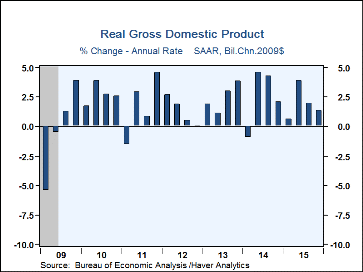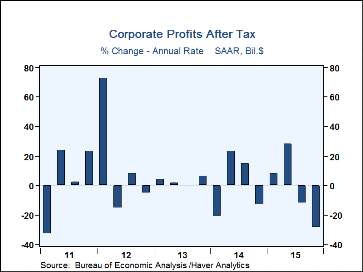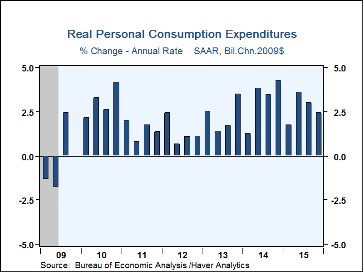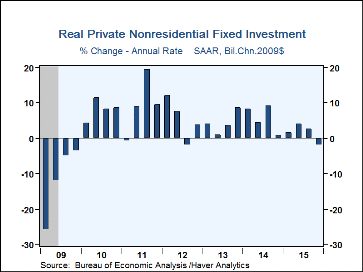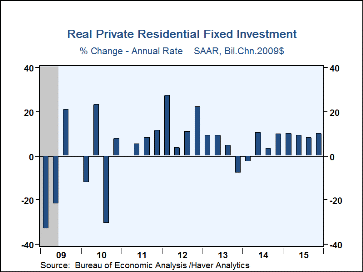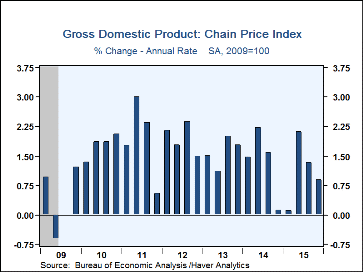 Global| Mar 25 2016
Global| Mar 25 2016U.S. GDP Growth Is Revised Higher; Corporate Profits Fall
by:Tom Moeller
|in:Economy in Brief
Summary
Economic growth was greater than previously estimated during Q4. The revised 1.4% increase (1.9% y/y) compared to last month's estimate of 1.0% and the advance estimate of a 0.7% rise. A 1.0% gain was expected in the Action Economics [...]
Economic growth was greater than previously estimated during Q4. The revised 1.4% increase (1.9% y/y) compared to last month's estimate of 1.0% and the advance estimate of a 0.7% rise. A 1.0% gain was expected in the Action Economics Forecast Survey. Economic growth during all of last year remained steady at 2.4%.
Reported for the first time, after tax corporate profits without inventory valuation & capital consumption adjustments declined 8.1% (-3.6% y/y), the fastest decline since Q1 2011. For all of last year, profits increased 3.3%, following negligible growth during 2014 & 2013.
Consumer spending accounted for much of the upward revision to GDP. Its 2.4% gain was raised from 2.0%, primarily as growth in service spending was increased to 2.8%. Recreation services spending jumped 14.2% (3.5% y/y) and restaurant & accommodations spending grew 4.4% (4.0% y/y), but housing & utilities outlays fell 1.5% (+0.5% y/y). Durable goods spending grew at an 3.8% rate as recreational good & vehicles rose 13.1% (9.5% y/y). Home furnishings & household equipment purchase grew 5.4% (6.0% y/y), but motor vehicle buying declined 5.7% (+0.7% y/y). Nondurable goods purchases improved just 0.6% growth (2.4% y/y), held back by a 2.5% decline (+2.0% y/y) in gasoline, heating oil and other energy goods purchases.
Business fixed investment spending declined at a little-revised 2.1% rate as spending on structures fell 5.1% (-3.5% y/y). Equipment spending fell 2.1% (+2.5% y/y), but intellectual property product purchases eased just 0.1% (+3.6% y/y). Residential investment strengthened 10.1% (9.4% y/y), revised from 7.9%. Government spending gained only 0.1% (1.1% y/y), held back by a 1.2% decline (+1.2% y/y) in state & local. Spending on national defense rose 2.8% (0.7% y/y).
Inventory investment sapped 0.2 percentage points from GDP growth, revised from 0.1 point. Net exports had a negative 0.1 percentage point effect on growth, revised from -0.3% points. The contribution was lessened by a 2.0% decline (-0.6% y/y) in exports, instead of -2.7%, and a 0.7% drop (+2.9% y/y) in imports, not just a slight decline.
The GDP price index rose at an unrevised 0.9% rate (1.1% y/y). The gain reflected a 0.3% rise (0.5% y/y) in the personal consumption price index. The nondurable goods price index fell 3.5% (-2.8% y/y) as gasoline prices declined. The durable goods price index declined 1.5% (-1.6% y/y) but services prices rose 1.9% (1.9% y/y). The price index for nonresidential fixed investment improved 0.4% but was unchanged y/y. The residential investment price index rose 2.1% (0.9% y/y).
The GDP figures can be found in Haver's USECON and USNA database. USNA contains virtually all of the Bureau of Economic Analysis' detail in the national accounts, including the integrated economic accounts and the recently added GDP data for U.S. Territories. The Action Economics consensus estimates can be found in AS1REPNA.
| Chained 2009 $ (%, AR) | Q4'15 (3rd Estimate) | Q4'15 (2nd Estimate) | Q4'15 (Advance Estimate) | Q3'15 | Q2'15 | Q4 Y/Y | 2015 | 2014 | 2013 |
|---|---|---|---|---|---|---|---|---|---|
| Gross Domestic Product | 1.4 | 1.0 | 0.7 | 2.0 | 3.9 | 1.9 | 2.4 | 2.4 | 1.5 |
| Inventory Effect | -0.2 | -0.1 | -0.4 | -0.7 | 0.0 | -0.1 | 0.2 | 0.0 | 0.1 |
| Final Sales | 1.6 | 1.1 | 1.1 | 2.7 | 3.9 | 2.0 | 2.3 | 2.4 | 1.4 |
| Foreign Trade Effect | -0.1 | -0.3 | -0.5 | -0.3 | 0.2 | -0.5 | -0.6 | -0.1 | 0.2 |
| Domestic Final Sales | 1.7 | 1.4 | 1.6 | 2.9 | 3.7 | 2.5 | 2.8 | 2.8 | 1.2 |
| Demand Components | |||||||||
| Personal Consumption Expenditures | 2.4 | 2.0 | 2.2 | 3.0 | 3.6 | 2.7 | 3.1 | 2.7 | 1.7 |
| Business Fixed Investment | -2.1 | -1.9 | -1.8 | 2.6 | 4.1 | 1.5 | 2.9 | 6.2 | 3.0 |
| Residential Investment | 10.1 | 7.9 | 8.2 | 8.2 | 9.4 | 9.4 | 8.9 | 1.8 | 9.5 |
| Government Spending | 0.1 | -0.1 | 0.7 | 1.8 | 2.6 | 1.1 | 0.7 | -0.6 | -2.9 |
| Chain-Type Price Index | |||||||||
| GDP | 0.9 | 0.9 | 0.8 | 1.3 | 2.1 | 1.1 | 1.0 | 1.6 | 1.6 |
| Personal Consumption Expenditures | 0.3 | 0.4 | 0.1 | 1.3 | 2.2 | 0.5 | 0.3 | 1.4 | 1.4 |
| Less Food/Energy | 1.3 | 1.3 | 1.2 | 1.4 | 1.9 | 1.4 | 1.3 | 1.5 | 1.5 |
Tom Moeller
AuthorMore in Author Profile »Prior to joining Haver Analytics in 2000, Mr. Moeller worked as the Economist at Chancellor Capital Management from 1985 to 1999. There, he developed comprehensive economic forecasts and interpreted economic data for equity and fixed income portfolio managers. Also at Chancellor, Mr. Moeller worked as an equity analyst and was responsible for researching and rating companies in the economically sensitive automobile and housing industries for investment in Chancellor’s equity portfolio. Prior to joining Chancellor, Mr. Moeller was an Economist at Citibank from 1979 to 1984. He also analyzed pricing behavior in the metals industry for the Council on Wage and Price Stability in Washington, D.C. In 1999, Mr. Moeller received the award for most accurate forecast from the Forecasters' Club of New York. From 1990 to 1992 he was President of the New York Association for Business Economists. Mr. Moeller earned an M.B.A. in Finance from Fordham University, where he graduated in 1987. He holds a Bachelor of Arts in Economics from George Washington University.


